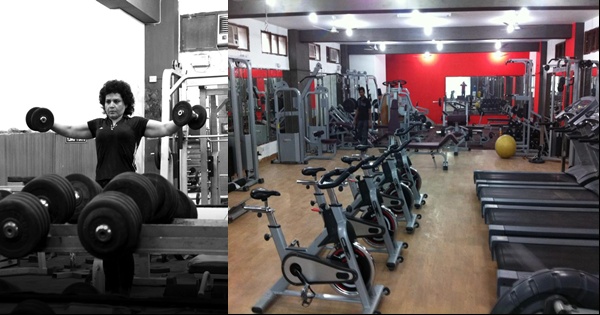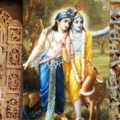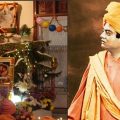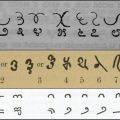Chandrayan 2: Dramatic Moments of ISRO’s 2nd Lunar Mission; An Analysis
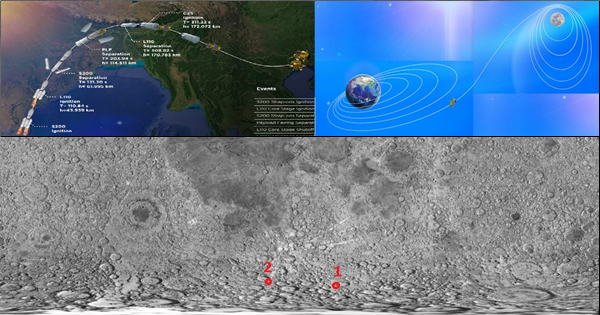
For a space scientist, the pain of loss of a launch vehicle or a satellite or a spacecraft after ten years of hard work, is a highly emotional affair. The agony is no less than the pain of a mother on the loss of a new born baby soon after delivery, after long wait and expectation of ten long months!

The graphs were going perfect till the last moment. But soon after the high precision soft landing manoeuvre, close to 1.9 km, a deviation of actual trajectory versus expected trajectory was noticed, but it was within the allowed range variability. But when the Vikram lander was close to 500 meters to touch down, we lost signal. The last recorded velocity is around 60 meters per second horizontally and around 48 meters per second vertically whereas the expected velocity at touch down is 2 meters per second or lesser.
This could be due to some glitch in the communication system in the lander (one of the horrible errors that could mar the landing missions others being, the excessive slope of the ground at the landing spot, unexpectedly shaped or slippery pebbles on the ground, heavy lunar dust arising during landing etc) or due to the disintegration of the whole lander itself, because of some issue in the soft-landing thrusters. Excessive thrust can destabilize the lander. Loss of all fuel can lead the lander into a free fall and crash on the surface. It is not clear if the lander came into contact with some high mountain peak ( a rare probability), on its way. Two landing sites were selected, each with a landing ellipse of 32 km x 11 km. The prime landing site (PLS54) is at 70.90267 S 22.78110 E (~350 km north of the South Pole-Aitken Basin rim and the alternate landing site (ALS01) is at 67.874064 S 18.46947 W. The prime site is on a high plain between the craters Manzinus C and Simpelius N, on the near side of the Moon.
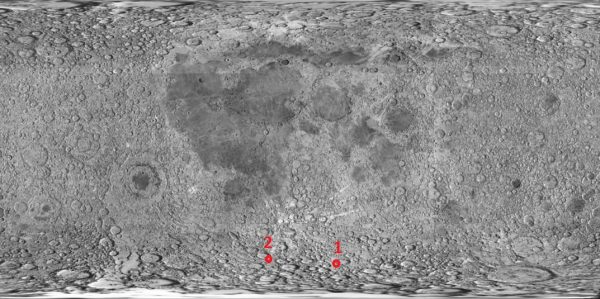
If it was only a communication loss, the lander Vikram (named after Dr Vikram Sarabhai the father of Indian Space Research) could even have already landed safely unable to tell us that it did. But still for the Pragyan rover to come out, we may require manual command to be sent which is not possible as we have lost signal contact with the lander or otherwise its automatic rover initiation trigger should occur despite crash-landing, without we knowing anything about it. In this case, the Pragyan rover will for ever remain caged in an intact Vikram lander, both unable to communicate to their makers on Earth.
If functional, Pragyan rover is designed to travel as much as 500 meters on lunar surface at a speed of 1 cm per second. It is a six wheeled robotic vehicle with a solar panel to power it weighing 27 kg and less than a meter across in size. It can also communicate with the lander Vikram as it moves away from the lander. Vikram lander weights 1471 kg and is less than 3 meters across. Both lander and rover are designed to outlast 1 lunar day (14 days). In the lunar night the lander and rover lack enough energy to prevent the cold freeze where temperature drops to minus 173 degree Celsius due to lack of atmosphere. Lander’s power output is 650 watts. R rover’s power output is 50 watts. The lander Vikram has capacity to communicate with IDNS (Indian Deep Space Network) at Byaluru near Bangalore (the mission control centre), with Chandrayan-2 orbiter and also with the wandering Pragyan rover.
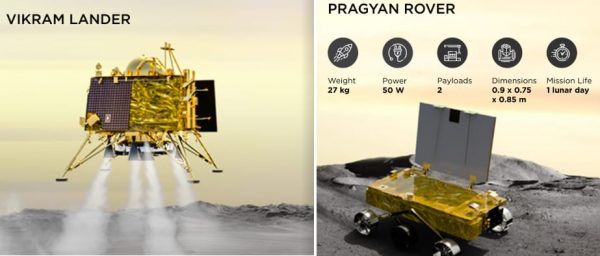
Some initial analysis report from ISRO has an indication that one out of the four thrusters (retro rockets that act as speed breakers) underperformed. This resulted in the other three thrusters to compensate by over performing. This tug of war between thrusters will cause spacecraft to spin uncontrollably and eventually crash land. If that is the case, next time around we will plan manual override for the retro rocket thrusters for the lander to mitigate such thruster issues in automatic mode. Light speed delay is 1.3 seconds from. Earth to Moon. So total signal delay for manual override will be 2.6 seconds, which is still good for manual control for mission activities lasting for few minutes, like this 20-minute-long landing process.
Some suggestions came from various space-enthusiasts that next time ISRO should have two landers, so that in case one lander fails to land, the other lander can do the landing. The flaw in this line of thought is that a lander like Vikram is close to 1 tonne in mass. A second back up lander adds 1 more tonne to payload causing GSLV Mark 3, India’s launch vehicle (in which I have worked in the initial design phase) cannot carry it. We have to rely on US or Russian launch vehicles then, which are capable of carrying that extra payload. It increases the mission cost 20-fold. Besides, handling dual landers increase the complexity of the mission four-fold.
A better alternative is to have back up communication modules in the lander and rover. A communication module will weight from 1 kg to less than 10 kg. Hence, having redundancy there do not pose much problems in the mass budget and weight management. Apart from this, for the lander thrusters and for the rover, we need redundant manual and automatic command-overrides.
If automatic commanding system fails, manual override should take over. If manual override fails, the automatic commanding system should take over. Multi-channel communication network between all the four concerned communication nodes (the mission control centre at Earth, the orbiter orbiting Moon, the lander and rover) with abundant redundancies can also help. Currently we have a dual parallel redundancy. The two parallel communication chains are: – 1) mission control – orbiter – lander – rover channel and an additional 2) mission control – lander – rover channel.
ISRO and other space agencies are exploring on micro and nano orbiters, landers and rovers along Micro and nano orbiters / landers can weigh as low as 100 kg to 10 kg, with rovers weighing as low as 10 kg to 1 kg. This involves creating orbiters, landers and rovers using MEMS (micro electro mechanical systems), micro systems technology and microelectronics. Once successful, the GSLV payload can consist of not two but as much as a dozen landers and rovers tucked into a single orbiter which will then eject these landers onto lunar surface like a bee spreading pollens! Already ISRO has launched hundreds of nano satellites developed by universities from across the world in one go using its PSLV launch vehicle.
Lunar surface is estimated to have deposits of Helium 3 isotopes in abundance – a light, non-radioactive isotope of helium with two protons and one neutron (common helium having two protons and two neutrons). Other than protium (ordinary hydrogen), helium-3 is the only stable isotope of any element with more protons than neutrons. Helium-3 was discovered in 1939. Helium 3 (He-3) is radiated by the sun, as part of the solar winds. On Earth much of it is lost due to the atmosphere cover. But the atmosphere less Moon stores all the He-3 it receives. He-3 provides waste free nuclear energy that could answer many of our energy problems. It will help not only India but entire planet. It can meet global energy demands for 3 to 5 years! It is worth trillions of dollars, about 5 billion USD a ton. There is around 1 million tons of He-3 in lunar soil in its upper layer of regolith. This is much higher than what is available on Earth though lesser than that available in the gas giants. As much as a quarter of it can be extracted and brought to Earth through future mining missions.
Pragyan indeed had an Alpha particle X Ray spectrometer and a Laser induced Breakdown spectroscope to detect various other chemical elements, isotopes and compounds including He-3 and water ice. Fortunately, the orbiter which is still intact and doing its function normally and will continue for another one year, is having a Large Area Soft X Ray Spectrometer which can do the He-3 study of larger areas of the Moon though closer analysis of the surface by Pragyan rover is not possible now.
ISRO is further investigating the causes and we would know things much more clearly soon enough. We will get more details as ISRO continues its initial investigations regarding the signal loss of Vikram lander close to touch down and finally concludes it studies.
What transpired later on Earth shows the innocence of a space scientist as his baby is lost in space. You can see the PM Sri Narendra Modi consoling a weeping ISRO Chairman Dr K Shivan by giving the comfort of his shoulders. Really touching and emotional moment. It brought tears into everyone’s eyes.
Out of three GSLV launches (GSLV D1 launched on 8th May 2003, GSLV F01 launched on 20th September 2004 and GSLV F02 launched on 10th July 2006, all of them Mark 1s) in which I was involved, one (GSLV D2) was a failure and the hurt felt is still fresh in my mind.
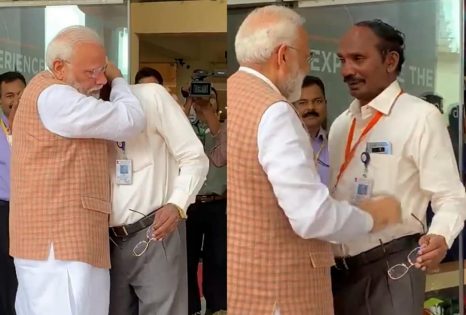
All is not lost.
The Chandrayan 2 orbiter is intact and healthy and will do science for the whole one year. If the landing spot is within the visibility range of the orbiter, its eyes can even detect the remains of the lander, its baby lost in the vastness of the lunar surface. The whole lander is around 2 meters in size. If it is intact it will be easier to spot by the Chandrayan 2 orbiter and if it has disintegrated into pieces, it will be much difficult to spot the small pieces in the lunar surface scans by the orbiter.
We can also initiate a follows up replication mission (Chandrayan 3) after studying the faults and incorporating corrections. Typically, a replicated mission can be ready in as short as 2 years.
To put things in perspective, NASA did around 11 crash lands to get it right and only then made a soft landing on Moon. Around 40% of lunar missions failed in the last 60 years. Of the 109 lunar missions during the period, 61 were successful and 48 had failed. This year, Israel, too, launched its lunar mission Beresheet in February 2018 but it crash-landed in April. In a span of a little more than a year, from August 1958 to November 1959, the US and the USSR launched 14 missions. Of these, only three, viz. Luna 1, Luna 2 and Luna 3 were successful. The USA, Russia and ESA had several failures before a successful Mars orbiter mission. Same is the case with their missions to Venus and other planets. ISRO got the Mars orbiter Mangalyan successful in the first attempt. It is a record no space agency has broken. Our Moon orbiter mission (Chandrayan 1) for which I did a small part too was a first attempt success mission. We are also the first space agency to officially confirm water on the Moon in the form of ice crystals mixed in the lunar soil, validating the Vedic wisdom that Moon is wet and the cause of wetness and moisture (aardram). Moon’s other name is Indu indicating wetness. Similarly, Soma another name of Moon indicates a divine drink of the devatas.

The Chandrayan orbiter had a fascinating journey riding on a GSLV Mark 3 launch vehicle, from ISRO’s space port Sathish Dhavan Space Center in Sriharikota (where I worked in the GSLV cryogenic engine team for 5 years) starting its journey on 22 July 2019 (initially scheduled on 14 July 2019). It made several orbiting maneuvers taking it in ever expanding elliptical orbits until it got captured into lunar gravity. After that in similar orbiting maneuvers it reduced its elliptical orbit elongation and achieved a near circular 100 x 100 km circular orbit around moon.
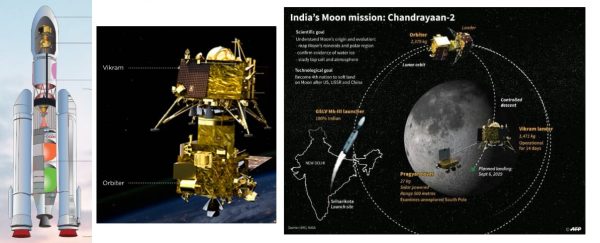
What is most heartening this time around, is that the whole nation is supporting ISRO.
Earlier the successes of ISRO were celebrated while in the failures ISRO was left to feel the pain all by itself. Nevertheless, the mission is not a failure since the Chandrayan 2 orbiter is intact and will do its work of analysing the Moon for 1 year in contrast to the lander and rover whose life was any way as short as 14 days.
The fact that the nation is standing beside ISRO means we Indians are now more matured and scientifically more advanced in our thinking process to understand the complexities of a space mission. That is more rewarding to know. As a nation we have matured. There is no going back from here onwards. We can be the most advanced nation which respects scientists, innovators, their innovations and their discoveries. In fact, it is this spirit of innovation of the whole nation that led USA to the high position it enjoys in scientific achievements.
In science, every failure is a great teacher.
The lessons are priceless! And we move on.
Note: At the time of publication of this article the following is the latest update on this story:-
Yesterday (8th September 2019) at 10 pm based on the thermal image analysis ISRO Chief Dr K Sivan has confirmed: “Vikram Lander has crash-landed on the moon. It is possible that the lander is still functional though. The damage is currently being evaluated”.
“The obstacles on the lunar surface may have been stopping the lander Vikram from receiving signals.” said Mylswamy Annadurai (Program Director for Chandrayaan-1 and Mangalyan).
One of the 8 payloads of Chandrayan 2 Orbiter is an imaging IR spectrometer. It also has a dual frequency SAR (synthetic aperture radar). These can provide initial imaging of the area including thermal maps. This seems to be the source of the thermal map which enabled the ISRO team to locate the Vikram lander by detecting the heat radiation emerging from it.
My understanding is that we still have not got the images of the lander from the 32 cm resolution OHRC camera, which is specifically purposed to study the landing site itself using high resolution imaging. It can easily detect the 2 meter sized lander unless it is concealed in a cave like or crater like enclosure or behind the obstacles of mountains and hills. Once that is available, we will get a better understanding about the integrity of the lander.
Earlier it was resembling India’s hairsplitting World Cup Cricket match loss. But now It is going like a suspense thriller movie climax!
Window for restablishing communication with Vikram is 14 days after which the lunar night will kick in in the area where it landed. Temperature of lunar surface at night goes to as low as minus 173 degree celsius which will sap away any remaining energy of the spacecraft and it will freeze.
Let us keep our prayers! Let us hope for the best.
Author is a former scientist who worked in ISRO (2001 to 2006) at SDSC-Sriharikota, as part of the Cryogenic team of GSLV. Took part in three GSLV launches, manning the liquid nitrogen Cryo Console of the Second Launch Pad (SLP) at Filling Control Canter and engaged in the GSLV count down process. Also worked briefly as part of the Chandrayan Study phase orbital simulations at VSSC-Trivandrum and got appreciation from Dr APJ Abdul Kalam during his visit at VSSC to meet young scientists. Involved in Mark 3 initial design phase, SRL (space capsule recovery) experiments and RLV (reusable launch vehicle) experiments.
He is currently engaged in the research of the geographical data present in the Mahabharata. In this capacity he has presented many papers in various international conferences. He owns a web-portal named AncientVoice containing 23,700 plus wikified pages on Veda Itihasa Puranas. He is also an artist and has visualized many scenes from the Mahabharata which was exhibited in different conference venues. Currently he is working in a leading software MNC focusing on creative research on Virtual Reality using devices like HoloLens. Combining this expertise with software technology he is engaged in creating Virtual Avataras of Itihasa personalities in Virtual Reality, Augmented Reality, Mixed Reality and Artificial Intelligence.
Jijith Nadumuri Ravi
Latest posts by Jijith Nadumuri Ravi (see all)
- 387 ‘Moplah Martyrs’ to be Removed from Freedom Struggle Dictionary - January 2, 2025
- Afghanistan Was Part of Rgvedic Horizon: A Historical Analysis - January 2, 2025
- Why Build a Statue for Rastra Purusha Krishna, the Founder of Delhi? - January 2, 2025



